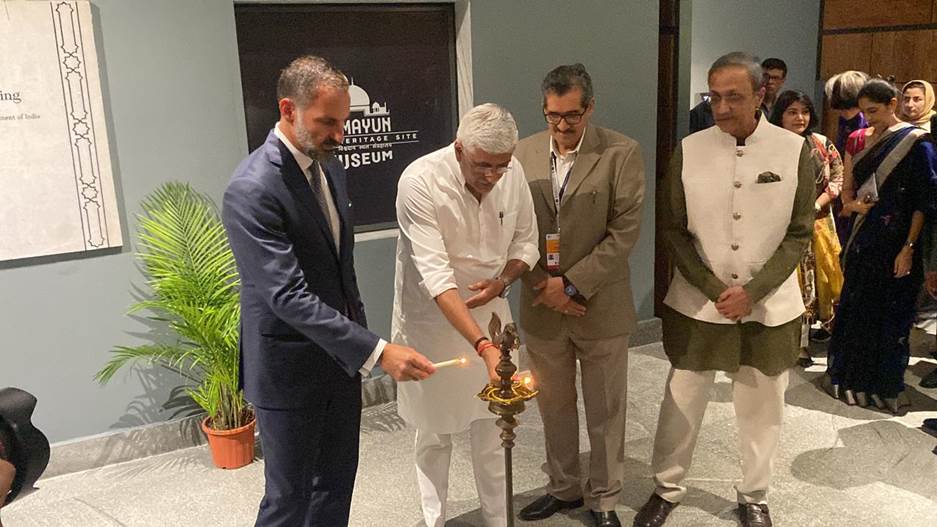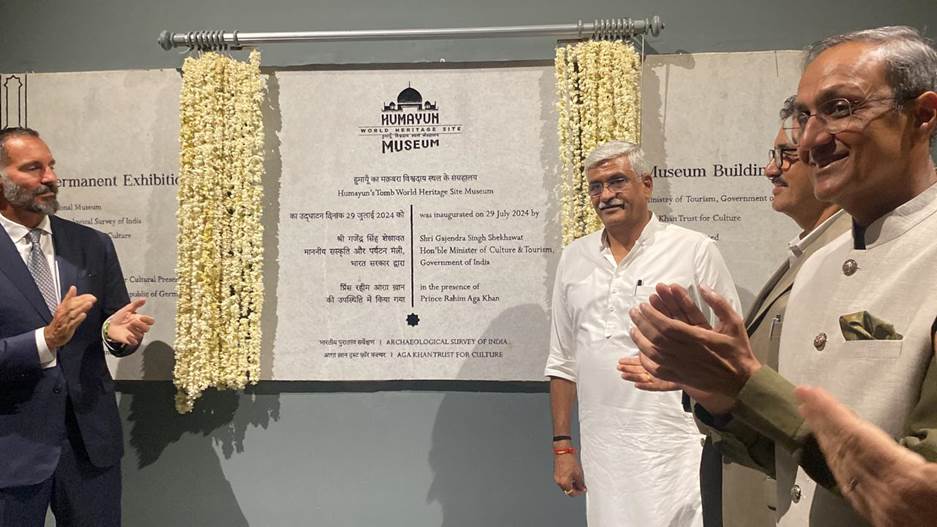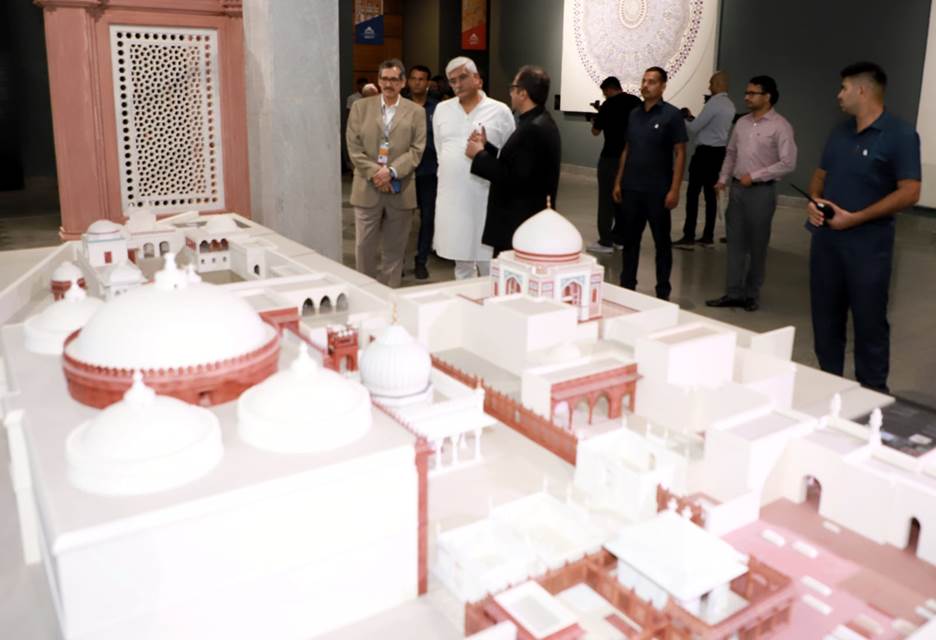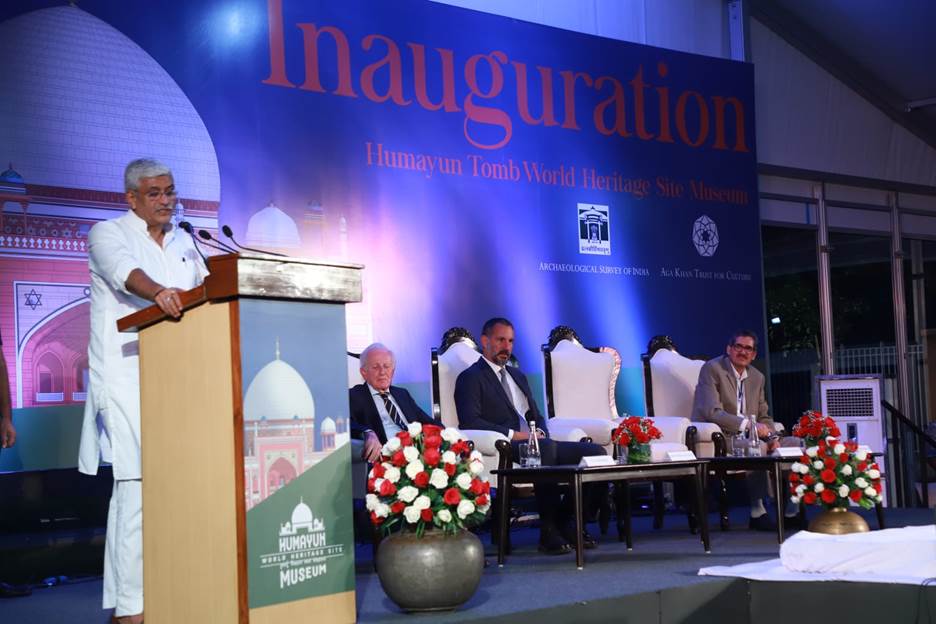Ministry of Culture
Union Minister Shri Gajendra Singh Shekhawat Inaugurates Humayun’s Tomb World Heritage Site Museum
प्रविष्टि तिथि:
29 JUL 2024 10:25PM by PIB Delhi
Union Minister of Culture and Tourism, Shri Gajendra Singh Shekhawat inaugurated the sprawling 100,000 square feet state of the art – Humayun’s Tomb World Heritage Site Museum at the Humayun’s Tomb, a UNESCO World Heritage site in New Delhi, today. The inauguration event was graced by the presence of Prince Rahim Aga Khan, dignitaries and esteemed guest from the Ministry of Culture, the Archaeological Survey of India and others.


The Museum is a facility of the Archaeological Survey of India designed and built in collaboration with the Aga Khan Trust for Culture (AKTC).
Inspired from the ancient ‘Baolis’ or stepped wells of Delhi, this underground museum is designed to retain the visual integrity of the monuments located in the complex, as per the UNESCO recommendation that site museums be provided at World Heritage Sites to provide the cultural context of the heritage edifice.
The Museum boasts over 500 esteemed artefacts - from the collections of the National Museum, Archaeological Survey of India and Aga Khan Trust for Culture. Miniatures, manuscripts, significant architectural elements from Humayun’s Mausoleum such as the original finial of the tomb, inspired by temples in India is made of copper of almost 100% purity, coins, contemporary art and craft pieces, astrolabes and celestial spheres amidst other metal ware, several stone inscriptions dating from the 14th century onwards, glass, textiles, etc, architectural models which assists to convey 700 years of stories developed through rigorous research by Archaeological Survey of India and the Aga Khan Trust for Culture.

In the inaugural speech, the Union Minister of Culture and Tourism, mentioned that this museum embarked on the historic extension of ‘Indraprastha’ the capital of the Pandavas in the epic Mahabharata on the bank of Yamuna, echoes the vision of the Prime Minister Shri Narendra Modi, i.e. the amalgamation of development as well as heritage – “Vikas bhi Virasat bhi”, as the museum will significantly enhance visitor experience by providing an understanding of the Outstanding Universal Value of this ensemble that includes monumental buildings built from the 14th to the 19th century. He further highlighted that the museum illustrates what the Prime Minister said in his inaugural address at the 46th World Heritage Committee meeting, that, “India is so ancient that every point of the present here tells the story of some glorious past”.

The Minister also hightlighted our deep routed cultural matrix as he talked about the images of Dara Shikoh’s Persian version of the Upanishad alongside his Quran, and Rahim’s couplets inscribed on the walls alongside his translations of the Ramayan. Both Rahim and Dara Shikoh are buried in this area and are amongst generations of saints associated with this sacred landscape.
The Minister also appreciated the efforts of the Archaeological Survey of India and the Aga Khan Trust for Culture in joining hands and building this site museum and setting up yet another example of public-private partnerships to be forged for various other historical sites across India. He urged all to visit this museum which is a significant and welcome addition to the historical city of Delhi.
Background
It is an UNESCO recommendation that interpretation centres/ site museums be provided at the entrance zone of significant World Heritage Sites to provide the cultural context of the heritage site and thus significantly enhance the visitor experience. The Museum is designed to be underground so as to retain the visual integrity of the monuments located in the complex.
Museum Galleries
Stone ramps allow visitors to descend into the gallery block. Visitors are welcomed with a 40 feet wide 3D illustration and finely crafted architectural models, which highlight several World Heritage monuments built here along the Yamuna River. Delhi’s 3000 year history is recounted through a map showing the seven cities of Delhi. Artefacts displayed here relate the story of the dynasties who built on the Purana Qila site over millennia.
The first principal Gallery, ‘Where the Emperor Rests’, is focused on the architecture of Humayun’s Mausoleum and the personality of Emperor Humayun – conveyed through stories of his travels, his deep interest in reading and astronomy.
The gallery, ‘Icons of a Sacred Landscape’, has exhibits focussed on the four iconic cultural personalities associated with the Nizamuddin area from the 14th century onwards. These are the 14th century Sufi Saint, Hazrat Nizamuddin Auliya, his disciple, poet Amir Khusrau– who created the Qawwali music genre. Also here are Rahim, commander-in-chief of Akbar’s army but more famous as a poet - for his coupletsand his translation of the Ramayan into Persian, andDara Shukoh – who translated the Upanishads into Persian.
Artefacts
The Museum has over 500 never seen before artefacts - from the collections of the National Museum, Archaeological Survey of India and Aga Khan Trust for Culture. Mughal miniatures, manuscripts, significant architectural elements from Humayun’s Mausoleum and monuments in the complex, coins, contemporary art and craft pieces, astrolabes and celestial spheres favoured by the Mughals amidst other metalware, several stone inscriptions dating from the 14th century onwards, glass, textiles, are all on display. Finely crafted architectural elements, carefully matching the original, realistic architectural models help convey 700 years of stories – some familiar but most revealed now following a decade of rigorous research carried out for the Museum by the inter-disciplinary team at the Archaeological Survey of India and the Aga Khan Trust for Culture
Support/ Donors
The foundation stone of the Museum was laid in April 2015. The museum building and exhibition has cost Rs 250 Crore. Towards building costs, an initial grant of Rs 49 Crore was provided by the Ministry of Tourism, Government of India. The Aga Khan Trust for Culture has also provided significant funds. AKTC has also received funding support from Havells India Private Limited, US Ambassadors Fund for Cultural Preservation, Embassy of the Federal Republic of India, Tata Trusts, Hilti Private Limited, Avanee Foundation, The Saluja Family Trust amongst others.
Museum Management
The Museum will lead to a significant increase in the time spent by visitors to the Humayun’s Tomb – Sunder Nursery World Heritage precinct. Over 300,000 school children who visit here annually will now leave with an enhanced understanding of the site. The Aga Khan Trust for Culture as Managing Trustee of the Government Sunder Nursery Management Trust will assist the Archaeological Survey of India in management of the Humayun’s Tomb World Heritage Site Museum for a period of 10 years from the date of opening.
****
BeenaYadav
(रिलीज़ आईडी: 2038794)
आगंतुक पटल : 5719